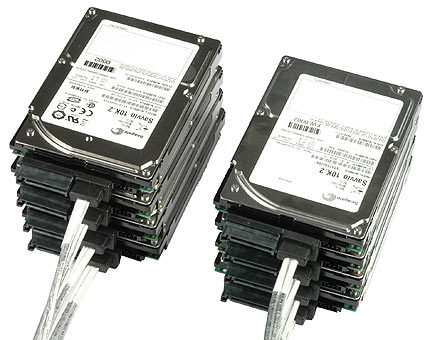Unified Serial RAID Controllers for PCIe
Drive Trends: 2.5" Moving In
The main reasons why 3.5" hard drives still dominate the professional world is their physical dimensions, which allowed them to accommodate the wide SCSI connectors. However, the smaller 2.5" form factor is much more attractive, since high spindle speeds can be realized with less strain on the components due to the smaller platter diameter. Dual port hard drives were an imperative for the highest-end applications, but the complex SCSI connectors were a no-go in the 2.5" world. SAS finally changed this: the SFF 8484 connector makes it possible to run either 2.5" or 3.5" drives, and either SAS or SATA protocols. The 2.5" size is more attractive for performance storage arrays, as you can increase the drive density while maintaining throughput levels, yet increasing the number of I/O operations per second. At the same time, a 2.5" hard drive requires considerably less energy than a 3.5" hard drive. This is becoming a major issue for professional users and data centers, where dozens, hundreds or even thousands of hard drives and servers have to not only be powered, but also need to be cooled, which again eats up huge amounts of energy. Cost, clearly, is one of the main driving forces for the 2.5" form factor.
Seagate 10,000 RPM Savvio Drives
The Savvio by Seagate is one of the first success stories in the 2.5" enterprise arena. The Savvio 10K.2 followed after the 10K.1, and the Savvio 15K.1 is one of the highest performing SAS drives on the market. We could not get eight Savvio 15K.1 drives in time, so we decided to go with eight Savvio 10K.2 models; capacity points of 73 GB and 146 GB are available. Our selection was the smaller size to keep benchmark run times within reasonable boundaries. This drive has a 16 MB cache, one 2.5" platter and a 3 Gbit/s SAS interface. As with all enterprise hard drives, it comes with a five-year factory warranty.
What About 3.5" Drives?
They will not die out, but 3.5" SAS drives will slowly disappear from the enterprise performance market in favor of 2.5" form factor units. When it comes to high capacity, 7,200 RPM SATA drives offer the best compromise between performance and capacity, and these have already reached capacity points of 1 TB per hard drive, while 10,000 RPM SAS and SCSI are stuck at 300 GB. To suit the requirements of enterprise storage, all major hard drive vendors offer SATA hard drive products, which are validated for 24/7 operations, and also come with five-year warranties. Seagate’s Barracuda ES, Hitachi UltraStar A7K1000 or E7K500, and Western Digital RAID Edition (RE) models are good examples.
Get Tom's Hardware's best news and in-depth reviews, straight to your inbox.

Patrick Schmid was the editor-in-chief for Tom's Hardware from 2005 to 2006. He wrote numerous articles on a wide range of hardware topics, including storage, CPUs, and system builds.
-
Rik ...well,Reply
- Unless RaidCore is trying to peddle their VST Pro software,...aka as Fulcrum proprietary based ? which BTW you said no to, I don't see any advantages here.
Why?, ZFS is free !
And, where are the Drives for Solaris, or the xBSD's , or even MacOSX !!!?
-and still no, becuase their newer 54xx series doesn't support the other 'ix OS's.
Nope, unfortunately, not much to see here.
so, based on the above, Adaptec 5805,... or Areca,... blows this.
-Rikster
-
aapocketz ReplyFor SAS, the two connector segments were merged, which makes it possible to attach a SAS drive to a SATA controller using the continuous connector, but you cannot hook up a SAS hard drive to a SATA controller using the SATA connector (SFF 8482).
I think this paragraph has an error. I believe it should read
For SAS, the two connector segments were merged, which makes it possible to attach a SATA drive to a SAS controller using the continuous connector, but you cannot hook up a SAS hard drive to a SATA controller using the SATA connector (SFF 8482).
In fact I believe the statement should have less emphasis on the connector as its the actual controller that appears to limit the connectivity, the connector is just keyed to allow you to plug SATA drives into SAS but not the other way around.
from wikipedia: "SATA 3.0 Gbit/s drives may be connected to SAS backplanes, but SAS drives may not be connected to SATA backplanes."
I believe the fact that signaling voltages are nearly double on a SAS drive is significant to mention.
Let me know if I am wrong, I just started playing around with a bunch of SAS drives so I am figuring this out as I go.
-
Factors like spindle speed, density, latency etc. effects drive performance as much or more than bandwidth. A 300GB 2.5 15K SAS drive will smoke a 1TB 7200 SATA drive simply because it has about twice the IOPS. The bandwidth is meaningless if you can't get the data on and off the disk at the speed of the bus. Furthermore, except for the WD Velociraptor 10K+ spindle speed drives are non-existent in SATA but are prevalent in SAS. So from an interface standpoint they are very close but SAS drives are really intended for entirely different markets and applications and budgets I might add.Reply
-
Bicom Systems Great article - thanks for the comparison! We also did a piece on SAS and SATA, if you're interested : http://blog.bicomsystems.com/sas-vs-sataReply
